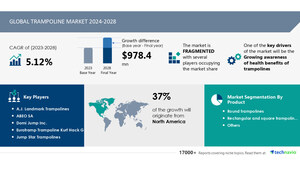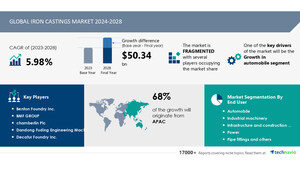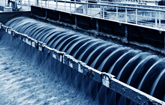NEW YORK, Sept. 4, 2024 /PRNewswire/ -- Report on how AI is driving market transformation- The global water softener market size is estimated to grow by USD 879.16 million from 2023-2027, according to Technavio. The market is estimated to grow at a CAGR of almost 8.5% during the forecast period. Growing consumer awareness about water-softening products and benefits of water softener systems is driving market growth, with a trend towards emergence of recent technological advances to improve the efficiency of water, salt, and regeneration. However, threat to the environment due to salt-based water softener systems poses a challenge. Key market players include A. O. Smith Corp., Aquia Water Treatment Systems LLC, BWT Holding GmbH, Culligan International Co., Enviro Water Products, EVOQUA WATER TECHNOLOGIES CORP., Haier Smart Home Co. Ltd., Harvey Water Softeners Ltd., Honeywell International Inc, Indian Ion Exchange and Chemicals Ltd., KENT RO Systems Ltd., Kinetico Inc., NuvoH20 LLC, Pearl Water Technologies, Pentair Plc, Pure Aqua Inc., Unilever PLC, US Water Systems Inc., Whirlpool Corp., and 3M Co..
AI-Powered Market Evolution Insights. Our comprehensive market report ready with the latest trends, growth opportunities, and strategic analysis- View your snapshot now
Forecast period |
2023-2027 |
Base Year |
2022 |
Historic Data |
2017 - 2021 |
Segment Covered |
End-user (Residential and Commercial), Product (Salt-based and Salt-free), and Geography (North America, Europe, APAC, South America, and Middle East and Africa) |
Region Covered |
North America, Europe, APAC, South America, and Middle East and Africa |
Key companies profiled |
A. O. Smith Corp., Aquia Water Treatment Systems LLC, BWT Holding GmbH, Culligan International Co., Enviro Water Products, EVOQUA WATER TECHNOLOGIES CORP., Haier Smart Home Co. Ltd., Harvey Water Softeners Ltd., Honeywell International Inc, Indian Ion Exchange and Chemicals Ltd., KENT RO Systems Ltd., Kinetico Inc., NuvoH20 LLC, Pearl Water Technologies, Pentair Plc, Pure Aqua Inc., Unilever PLC, US Water Systems Inc., Whirlpool Corp., and 3M Co. |
Key Market Trends Fueling Growth
In response to growing environmental concerns, water softener manufacturers are prioritizing eco-friendly and sustainable solutions. To address water wastage, they're introducing advanced water softening systems that reduce water consumption during regeneration by up to 20%. These systems also improve salt efficiency, using 4,000 grains of hardness removed per pound of salt instead of the traditional 3,350 grains. This leads to a decrease in sodium and chloride content in water from salt-based systems. Leading manufacturers like Culligan and Water-Right Inc. Have already launched regeneration-efficient water softening systems using demand-initiated regeneration (DIR). Culligan's Culligan Connect app, compatible with their HE softeners, provides users with real-time water stats, system alerts, and manual regeneration capabilities. Water-Right's Wripli app offers similar features, allowing homeowners to monitor water usage, adjust regeneration cycles, and receive system alerts wirelessly. These technological advancements are expected to boost the global water softener market by enhancing efficiency and reducing environmental impact.
The water softener market is witnessing significant trends with the emergence of advanced technologies like 3G AQUA and 5G AQUA. These technologies offer added functionalities, making water softening more efficient for various industries and households. The chemical methods used in water softening by the manufacturing sector face environmental apprehensions, leading to a shift towards sustainable products. Hard water causes scale buildup in appliances like Dishwashers and Fixtures, affecting their performance and increasing cost. Industries like chemical factories, power generation, and refineries are major consumers of soft water due to their high water usage. Start-up companies like Nirvana Water Sciences are introducing natural conditioning systems, providing a cost-effective and sustainable alternative to chemical methods. The electric segment is growing due to the convenience it offers over the manual segment. Hard water, rich in calcium and magnesium, can lead to health problems and affect the quality of Detergents, Soaps, and Shampoos. Strict regulations in the pharmaceuticals industry necessitate the use of soft water. Population growth and industrial activities are increasing the demand for water softening solutions in both developed and low-income regions. Technologies like reverse osmosis and distillation are popular in treating polluted hard water. The food and beverage industry, plumbing systems, and pipes also benefit from soft water. Sodium-based softeners are gaining popularity due to their ease of use, but concerns over unsafe health effects persist. Overall, the water softener market is expected to grow due to the increasing awareness of the benefits of soft water.
Insights on how AI is driving innovation, efficiency, and market growth- Request Sample!
Market Challenges
- The water softener market may face challenges due to the environmental impact of traditional salt-based water softening systems. Sodium and potassium ions from NaCl used in these systems can negatively affect aquatic life and ecosystems, as well as reduce soil oxygen levels and harm plant growth. High concentrations of these salts also increase total dissolved solids (TDS) levels in groundwater and reclaimed wastewater, exceeding the prescribed limit for general uses. Additionally, the regeneration process of these systems requires large volumes of water, leading to water wastage. Regulations, such as the ban on water-softening systems in certain US states, and the inefficiency of backwashing filtration systems, further hinder market growth.
- The Water Softener Market faces several challenges in various industries. Hard water causes scale buildup in Fixtures, Pipes, and Plumbing systems, affecting their efficiency and increasing maintenance costs. In Food and Beverage and Pharmaceuticals industries, hard water can lead to product contamination and quality issues. In low-income regions, affordability is a concern for manual segment users. Ion exchange is a common softening method, but strict regulations limit its use due to sodium wastage. Natural conditioning systems from start-ups like Nirvana Water Sciences offer sustainable alternatives. Industrial activities in Power generation and Refineries create polluted hard water, requiring advanced water treatment systems like reverse osmosis. Health problems from unsafe water and high salt content in soft water are concerns for consumers using soaps and shampoos. Scale buildup in Water heaters and Washing machines reduces their lifespan and efficiency. Magnesium and other minerals in hard water impact water purity, affecting the overall quality of soft water. The market growth is influenced by population increase, industrial expansion, and strict regulations in the Manufacturing sector.
Insights into how AI is reshaping industries and driving growth- Download a Sample Report
Segment Overview
This water softener market report extensively covers market segmentation by
- End-user
- 1.1 Residential
- 1.2 Commercial
- Product
- 2.1 Salt-based
- 2.2 Salt-free
- Geography
- 3.1 North America
- 3.2 Europe
- 3.3 APAC
- 3.4 South America
- 3.5 Middle East and Africa
1.1 Residential- The global residential construction market is experiencing growth due to urbanization, government funding, low housing loan interest rates, and the rise of high-rise buildings. Urbanization has led to an increase in the demand for residential buildings in urban areas, with the global urban population reaching 57.11% in 2021. Consumers in these areas prefer convenience and safety, and hard water, which is commonly supplied and contains calcium and magnesium, can hinder these preferences. Water softener systems offer a solution by providing soft water, allowing soaps and detergents to dissolve easily, reducing instances of clogged pipes and water heaters, and eliminating the need for harsh chemicals. Additionally, municipal water often contains chloramine, a corrosive disinfectant, which water softeners help reduce. By minimizing scaling and protecting plumbing, dishes, and appliances, water softeners offer numerous benefits, making them a desirable choice for residential consumers.
Download complimentary Sample Report to gain insights into AI's impact on market dynamics, emerging trends, and future opportunities- including forecast (2023-2027) and historic data (2017 - 2021)
Research Analysis
The water softener market encompasses various methods and technologies used to remove calcium and magnesium ions from hard water, enhancing its quality for household and industrial applications. The market includes the chemical methods employed in the chemical factories industry, as well as the manual and electric segments. The cost-effective manual segment uses ion exchange resins, while the electric segment employs regenerative systems. Detergents and dishwashers benefit significantly from softened water, ensuring better efficiency and longevity. Environmental apprehensions surrounding the use of chemicals in water softening have led to the emergence of alternative methods like natural conditioning systems. Companies like Nirvana Water Sciences offer reverse osmosis systems and distillation processes that eliminate scale buildup without the use of chemicals. In low-income regions, affordable solutions like salt-based ion exchange systems remain popular. Despite advancements, cost-effectiveness and environmental concerns continue to shape the market dynamics.
Market Research Overview
The Water Softener Market encompasses various technologies and applications aimed at addressing hard water issues and improving water quality. Hard water, rich in minerals like calcium and magnesium, can lead to scale buildup in appliances, plumbing systems, and fixtures, reducing efficiency and increasing costs. Traditional methods include chemical methods used in the chemical factories industry, but environmental apprehensions and health concerns have led to the emergence of sustainable, physical methods like ion exchange and reverse osmosis. Appliances like washing machines, dishwashers, and water heaters benefit from soft water, while industries like Manufacturing, Power generation, refineries, and Food and beverage rely on water treatment systems for optimal production. Start-up companies and Nirvana Water Sciences introduce added functionalities to cater to diverse consumer needs. Detergents, soaps, shampoos, and dishwasher detergents perform better in soft water. Strict regulations and sustainable product trends drive innovation in the market, with 3G Aqua and 5G Aqua technology offering advanced solutions. The market caters to both electric and manual segments, with the former gaining popularity due to its convenience. The market size is influenced by population growth, industrial activities, and the increasing awareness of water purity and health concerns in low-income regions. Despite the benefits, the market faces challenges from the high cost of installation and maintenance, as well as the wastage of water during the softening process.
Table of Contents:
1 Executive Summary
2 Market Landscape
3 Market Sizing
4 Historic Market Size
5 Five Forces Analysis
6 Market Segmentation
- End-user
- Residential
- Commercial
- Product
- Salt-based
- Salt-free
- Geography
- North America
- Europe
- APAC
- South America
- Middle East And Africa
7 Customer Landscape
8 Geographic Landscape
9 Drivers, Challenges, and Trends
10 Company Landscape
11 Company Analysis
12 Appendix
About Technavio
Technavio is a leading global technology research and advisory company. Their research and analysis focuses on emerging market trends and provides actionable insights to help businesses identify market opportunities and develop effective strategies to optimize their market positions.
With over 500 specialized analysts, Technavio's report library consists of more than 17,000 reports and counting, covering 800 technologies, spanning across 50 countries. Their client base consists of enterprises of all sizes, including more than 100 Fortune 500 companies. This growing client base relies on Technavio's comprehensive coverage, extensive research, and actionable market insights to identify opportunities in existing and potential markets and assess their competitive positions within changing market scenarios.
Contacts
Technavio Research
Jesse Maida
Media & Marketing Executive
US: +1 844 364 1100
UK: +44 203 893 3200
Email: [email protected]
Website: www.technavio.com/
SOURCE Technavio

WANT YOUR COMPANY'S NEWS FEATURED ON PRNEWSWIRE.COM?
Newsrooms &
Influencers
Digital Media
Outlets
Journalists
Opted In




Share this article